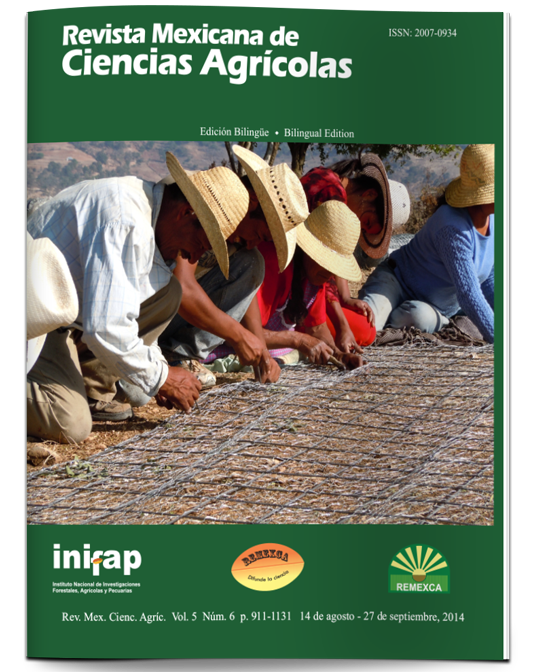‘Sainero’: new variety of xoconostle for the northern region of central Mexico
DOI:
https://doi.org/10.29312/remexca.v5i6.895Keywords:
Opuntia matudae Scheinvar subsp. Purpurea subsp. Nov., nutritional quality, yield, variety of common useAbstract
From the cultural point of view, xoconostles have been an important factor of economic livelihood of farmers in semi- arid areas of Mexico, which are used as food and traditional medicine. Unfortunately, wild prickly pear are undergoing a process of rapid and irreversible destruction as a result of the opening of land for cultivation and grazing, among other causes. A new horticultural form of the genus Opuntia Miller (Cactaceae), considered as a commonly used variety, found in the municipality of Sain alto, Zacatecas, Mexico, known as xoconostle ‘Sainero’. It was evaluated from 2008 to 2010 and found that its mature cladodes or pads are broad obovate, with 11 to 13 sets of areole, with 4 to 6 spines per areole; blooms once per year and reaches commercial maturity in the month of February of the following year that f lowering occurs.
The fruit of ‘Sainero’ is small to medium size (56 cm) and has a broad obovate shape, with the floral scar slightly sunken with an external red color, bright, reddish to whitish walls, broad (11.4 mm, characteristic of xoconostle), acidic (pH 3.1), pink dry to semi-dry and tasteless funiculus, firm, low sugar content (6.3 °Brix) and with few fully developed seeds (137). The average yield on three-year evaluation was 19.16 kg ha-1 and its fruits will remain for more than 12 months on the plant, after the onset of ripening, which gives a comparative advantage over other integrated varieties for commercial production, as Xoconostle Manzano (O. joconostle F.A.C. Weber) grown in the central region of Mexico. This variety counts with the registration number XOC-023-031111 from CNVV-SNICS and is being validated under the conditions of Calera, Zacatecas, in order to establish its adaptability and potential to increase the population for the commercial production of prickly pear in the semiarid region of north central Mexico.
Downloads
Downloads
Published
How to Cite
Issue
Section
License
The authors who publish in Revista Mexicana de Ciencias Agrícolas accept the following conditions:
In accordance with copyright laws, Revista Mexicana de Ciencias Agrícolas recognizes and respects the authors’ moral right and ownership of property rights which will be transferred to the journal for dissemination in open access. Invariably, all the authors have to sign a letter of transfer of property rights and of originality of the article to Instituto Nacional de Investigaciones Forestales, Agrícolas y Pecuarias (INIFAP) [National Institute of Forestry, Agricultural and Livestock Research]. The author(s) must pay a fee for the reception of articles before proceeding to editorial review.
All the texts published by Revista Mexicana de Ciencias Agrícolas —with no exception— are distributed under a Creative Commons License Attribution-NonCommercial 4.0 International (CC BY-NC 4.0), which allows third parties to use the publication as long as the work’s authorship and its first publication in this journal are mentioned.
The author(s) can enter into independent and additional contractual agreements for the nonexclusive distribution of the version of the article published in Revista Mexicana de Ciencias Agrícolas (for example include it into an institutional repository or publish it in a book) as long as it is clearly and explicitly indicated that the work was published for the first time in Revista Mexicana de Ciencias Agrícolas.
For all the above, the authors shall send the Letter-transfer of Property Rights for the first publication duly filled in and signed by the author(s). This form must be sent as a PDF file to: revista_atm@yahoo.com.mx; cienciasagricola@inifap.gob.mx; remexca2017@gmail.
This work is licensed under a Creative Commons Attribution-Noncommercial 4.0 International license.



